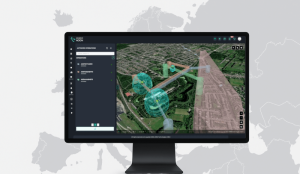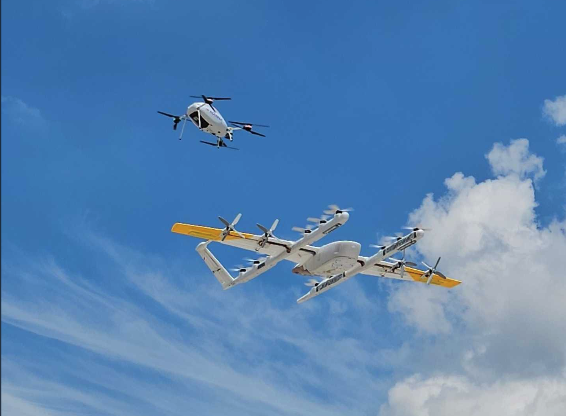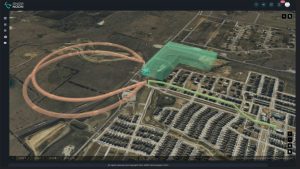The first live flights in shared airspace as part of the US UTM Implementation programme involving ANRA, Manna, DroneUp, Zipline and Wing started on June 25, 2024. What has been the progress since then and what does the future hold for decentralised, federated UTM? Philip Butterworth-Hayes reports.
The commercial future of the drone industry relies on scaling up commercial drone operations so routine beyond visual line of sight (BVLOS) autonomous operations in cities become integrated into the daily lives of communities and businesses.
This vision part is easy – getting there has proved torrid, with regulators around the world slow to certify the core information providers and UAS traffic management providers. While sporadic drone delivery programmes have sprung up in many parts of the world they are often by exception, rather than with full integration into the surrounding airspace, and therefore will not scale to their full potential.
For many drone delivery companies there has been a beacon of light, however. In June 2024 a small consortium of drone delivery companies began to coordinate their commercial flight operations in Dallas, Texas, as part of the US UTM Implementation programme, where drone companies share their operational data via industry standards, in a bottom-up, decentralised way, but under the supervision of the regulator (See below: “A distributed and open UTM architecture – the concept and milestones to deployment).
The role of the regulator in providing regulatory oversight rather than writing prescriptive, complex rules which can be open to interpretation, has been crucial in the way the network was established and has been able to scale. Industry has been able to drive the process in response to the FAA/NASA UTM Operational Evaluation concept, in which the regulator could apply a Near-Term Approval Process (NTAP) for UTM Services to evaluate safety mitigation. The FAA has overseen the progress of the implementation and provided Letters of Acceptance to use UTM in commercial operations to strategically coordinate overlapping BVLOS flights.
“The implementation has showcased how industry and regulators can come together to unlock the next milestones in scaled drone operation,” said Reinaldo Negron, Head of UTM, Wing. “The FAA identified a very clear operational aspect to solve for – mitigating UA to UA collision risk for BVLOS operations – and the industry answered in less than a year. The result is an open, national implementation based on industry consensus standards and with the ability to grow and evolve alongside industry and FAA learnings.”
One year on there are now 13 industry participants in the programme, with many more potential participants checking technical onboarding criteria, four FAA Letters of Acceptance issued, and five US states with operations supported by UTM strategic coordination services: Arkansas, New York, North Carolina, Texas, and Utah. The initial GUTMA task force that developed the governance agreement template have been publicly posted and shared with a global community of regulators, standards development organizations, and industry members, easing the passage for new organisations wishing to join the programme and existing members to more easily scale their operations.
“Supporting Amazon Prime, Manna Drone Delivery, the City of Fort Worth and the Arlington Police Department showcases the versatility of our technology, whether it’s precision logistics in urban neighbourhoods or mission-critical public safety operation,” said Amit Ganjoo, Founder and CEO, ANRA Technologies. “These deployments demonstrate how mature UTM infrastructure is essential to unlocking the full potential of drone innovation in the United States.”
There have of course been challenges to developing the network. Beyond the core network developers – the FAA and the original industry stakeholders, who had to agree how to handle priority flights, for example – newcomers without an aviation background or with different interpretations of the concept of operation meant that the governance framework has had to be regularly updated, a process that takes ninety days. The onboarding process for new UTM service suppliers (USSs) is a sixty-day procedure with an automatic thirty-day extension. But not everyone has been able to meet that timeline so the governance committee is now considering extending the onboarding period.
Crucially for a strategic deconfliction traffic management system, there have been no major safety incidents. There have been incidents at the qualification stage where USSs have not met their minimum performance requirements laid down in the service level agreements, where company system failures have had a knock-on impact on the wider network, preventing the authorisation of new flights. But these have been very rare and were quickly dealt with, according to industry stakeholders.
The system has allowed Wing, for example, to more easily share airspace with other drone delivery companies in new locations. In all its operations, including recently announced expansion locations in the USA (Charlotte, Houston, Orlando, Tampa, Atlanta), will have strategic coordination capability. “Increasingly complex, commercial, BVLOS operations are critical to meet the growing demand we are seeing every day,” said Wing’s Reinaldo Negron. “Operationalized UTM, particularly allowing for strategic coordination, supports these types of scaled operations. Coordination of overlapping BVLOS operations is no longer a limiting factor for operations in increasingly shared airspace, including drone delivery. Just as we have seen in Dallas and elsewhere, we expect multiple drone delivery companies and other BVLOS operations to efficiently share the airspace, removing a potential barrier for scaled operation.”
Recent presidential executive orders aimed at speeding approvals of BVLOS and other more complex drone operations are likely to be a catalyst to implementing the decentralised UTM concept more widely in the USA.
“As the world’s largest autonomous delivery system, Zipline has played a leading role helping to shape and implement an industry-wide UTM program, and we’ve appreciated the opportunity to work with our industry partners in building the future of unmanned traffic management at scale,” said Peter Sachs, Head of Airspace Integration Strategy at Zipline. “The FAA has indicated that UTM will be an important part of the forthcoming BVLOS Notice of Proposed Rulemaking, and we are excited to see our lessons learned incorporated into this important set of rules.”
The systems proponents hope that taking this decentralised approach will allow them to scale more easily.
“It helps from an ecosystem point of view,” said Amit Ganjoo. “It should allow for the development of specialised USSs emerge specific to certain use cases and verticals; it certainly allows for a more competitive landscape. The bar to certification for these services in Europe is somewhat higher so that means there will probably be fewer of these entities offering these services.”
And the concept is about to go global. The US UTM Implementation’s work will contribute to an Airspace Modernisation Strategy grant as part of the UK’s Civil Aviation Authority’s Airspace efforts to integrate drones into the UK Airspace System.
“Since 2023, Manna has flown in the US using UTM — alongside industry leaders like Wing, Zipline, DroneUp, and ANRA Technologies,” said Andrew Patton, Head of US, Manna Air Delivery. “With the support of the FAA and NASA, we and our partners have demonstrated that shared, real-world unmanned traffic management can support varied drone operations. At Manna, we view UTM as essential infrastructure for enabling safe, reliable drone services at scale. We’re growing rapidly across Europe and preparing to greatly expand our US operations next year.”
At the moment it is difficult to compare how the different economic models of a decentralised UTM system and a centralised European U-space architecture will vary, as each USS has a different economic model. Some participants are essentially drone delivery companies with an integrated UTM functionality while others are essentially UTM service providers offering services to a wide range of drone operating customers and there is a third set of public service organisations funded entirely differently.

“I think as we start translating this to Europe the models will be pretty similar; the price points will be different because it’s a different market but the way you licence and engage these similar are likely to be the same,” said ANRA’s Amit Ganjoo.
For some advocates, this decentralised approach to implementing digital traffic management concepts through operational data-sharing via industry standards has the potential to impact the wider air traffic management sector.
“It was exciting to watch the US UTM Implementation take shape over the last couple years and become an indispensable piece of our operations,” said Andy Thurling, Vice President of Airspace Innovation, DroneUp. “I’m even more excited about what this means for the future of air traffic management. DroneUp sees the low altitude airspace as an ideal environment for the aviation community to evolve new concepts of collaborative traffic management and better understand the balance in human/machine teaming all while we expand the way we assess, measure, and mitigate risk.”
| A distributed and open UTM architecture – the concept and milestones to deployment
The idea is simple: operators and their service providers share the airspace in their day-to-day beyond visual line of sight (BVLOS) operations, based on UAS-to-UAS coordination, using industry standards. A group of operators, a service provider, the FAA, and NASA – supported by GUTMA, InterUSS, and MAAP – began to make this idea a reality in summer 2023. It has been a transparent effort, with all materials published, contributions from NASA, MAAP, GUTMA, and InterUSS, and the industry community, and oversight by the FAA. Open resources, such as GUTMA task force publications and open source interoperability solutions from the InterUSS Platform, have underpinned this work New participants are onboarded, having checked their capabilities against established industry consensus standards, testing and validating their software, running simulations of flights in shared airspace, and working toward live flights in shared airspace. May 2024 – Industry governance framework is established and published (Github) to provide governance and data sharing agreement templates for the global community. June 2024 – Manna Drone Delivery and Wing (operators) and ANRA (service provider) ran the first operational flights in shared airspace to use digital, automatic strategic coordination on June 25, 2024. July 2024 – FAA grants Letters of Acceptance (LOAs) to Wing and Zipline to use UTM in commercial operations to strategically coordinate overlapping BVLOS flights. November 2024 – DroneUp granted a FAA Letter of Acceptance. Arlington Police Department, Manna, and Wing developed an overlapping operation in North Texas using UTM strategic coordination for an audience of over 30 different regulators and members of industry from various countries at the GUTMA annual conference. November 2024 – ANRA Technologies was the first non-vertically integrated UTM provider to receive a FAA LOA for a Strategic Coordination service to support overlapping BVLOS flights. December 2024 – FAA adds ANRA’s Letter of Acceptance for strategic coordination to Arlington, Texas Police Department’s COA. May 2025 – Ongoing commercial flights are overlapping regularly in Texas (beginning with Flytrex and Wing). Committees are further defining and refining technological or governance capabilities to address other aspects of strategic coordination or other fields within UTM. |
-
- .





